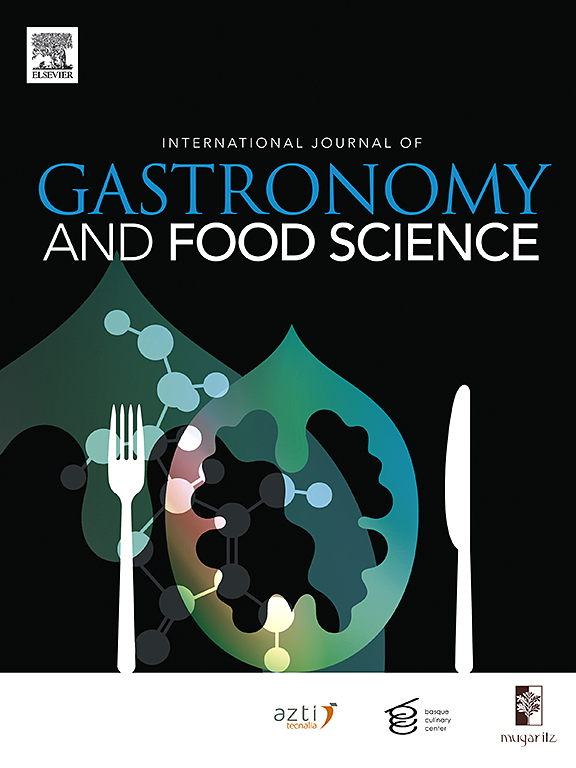Innovative fortified kale soup formulation designed for the elderly
IF 3.6
2区 农林科学
Q2 FOOD SCIENCE & TECHNOLOGY
International Journal of Gastronomy and Food Science
Pub Date : 2025-05-28
DOI:10.1016/j.ijgfs.2025.101216
引用次数: 0
Abstract
The nutritional needs of the elderly require immediate attention. Strategies to incorporate healthy, high-fibre, protein-rich ingredients into traditional diets have been identified to enhance health benefits. This study aimed to develop a new food product specifically for older adults, using kale (Brassica oleracea L. var. acephala DC), and to evaluate its nutritional, sensory, and antioxidant properties. Acceptance was assessed among institutionalised elderly individuals in Galicia (Spain) and Northern Portugal. Fresh kale, both blanched and non-blanched, was air-dried at 80 °C for 2 h. The dehydrated kale was then ground into small particles and/or powder. Blanching did not negatively affect the dehydrated samples’ protein, fibre, or carbohydrate content. The sensory analysis showed 0.5 %–0.8 % kale enrichment improved taste and texture, balancing appeal without bitterness or roughness from higher concentrations. Incorporating non-blanched dehydrated kale (at concentrations of 0.5 %, 0.8 %, and 1.0 %), pea protein isolate (0.58 %), and calcium lactate (0.25 %) into a traditional soup base resulted in a product with a higher protein content. A 240 g serving of this soup (dehydrated kale 0.8 %: sliced 0.5, and flour 0.3) provided approximately 10 % of the daily dietary fibre recommendation. The nutrient-dense soup was well received (66 %) by the Portuguese and was accepted (52 %) by Galician elders, offering a viable alternative to commercial nutritional supplements and common chewing hard foods rich in fibre and protein.
为老年人设计的创新强化羽衣甘蓝汤配方
老年人的营养需求需要立即予以关注。已经确定了将健康、高纤维和富含蛋白质的成分纳入传统饮食的战略,以增强对健康的益处。本研究旨在利用羽衣甘蓝(Brassica oleracea L. var. acephala DC)开发一种专门针对老年人的新食品,并评估其营养、感官和抗氧化性能。接受程度在加利西亚(西班牙)和葡萄牙北部的机构老年人中进行了评估。新鲜羽衣甘蓝,包括焯过的和未焯过的,在80°C风干2小时。然后将脱水的羽衣甘蓝磨成小颗粒和/或粉末。焯水对脱水样品的蛋白质、纤维或碳水化合物含量没有负面影响。感官分析表明,添加0.5% - 0.8%的羽衣甘蓝改善了口感和质地,平衡了高浓度的苦味和粗糙感。将未焯水的脱水羽衣甘蓝(浓度分别为0.5%、0.8%和1.0%)、豌豆分离蛋白(0.58%)和乳酸钙(0.25%)加入传统的汤底中,可以得到蛋白质含量更高的产品。一份240克的这种汤(脱水羽衣甘蓝占0.8%,切片占0.5%,面粉占0.3%)提供了大约10%的每日膳食纤维推荐量。这种营养丰富的汤深受葡萄牙人(66%)和加利西亚老年人(52%)的欢迎,为商业营养补充剂和富含纤维和蛋白质的普通咀嚼硬食物提供了可行的替代方案。
本文章由计算机程序翻译,如有差异,请以英文原文为准。
求助全文
约1分钟内获得全文
求助全文
来源期刊

International Journal of Gastronomy and Food Science
Social Sciences-Cultural Studies
CiteScore
5.30
自引率
10.50%
发文量
170
审稿时长
45 days
期刊介绍:
International Journal of Gastronomy and Food Science is a peer-reviewed journal that explicitly focuses on the interface of food science and gastronomy. Articles focusing only on food science will not be considered. This journal equally encourages both scientists and chefs to publish original scientific papers, review articles and original culinary works. We seek articles with clear evidence of this interaction. From a scientific perspective, this publication aims to become the home for research from the whole community of food science and gastronomy.
IJGFS explores all aspects related to the growing field of the interaction of gastronomy and food science, in areas such as food chemistry, food technology and culinary techniques, food microbiology, genetics, sensory science, neuroscience, psychology, culinary concepts, culinary trends, and gastronomic experience (all the elements that contribute to the appreciation and enjoyment of the meal. Also relevant is research on science-based educational programs in gastronomy, anthropology, gastronomic history and food sociology. All these areas of knowledge are crucial to gastronomy, as they contribute to a better understanding of this broad term and its practical implications for science and society.
 求助内容:
求助内容: 应助结果提醒方式:
应助结果提醒方式:


